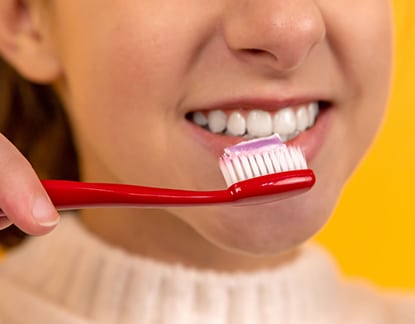The Focus on Fluoride: What it is and Why Your Teeth Love it
Q: What is fluoride, and how can it improve your dental health?
A: “Sodium fluoride” is typically listed as the active ingredient on most brands of toothpaste, including what’s likely in your bathroom drawer at home. Sodium fluoride is a compound that forms when the elements fluoride and sodium bind together. Years of research and evidence indicates that such fluoride compounds are very useful for maintaining oral health.
Q: Where can I find fluoride?
A: Fluoride occurs naturally in the environment, but as its benefits have become apparent, fluoride is now incorporated into our daily lives through various methods and products.
Surprisingly, of the main ways that we obtain fluoride goes largely unnoticed! Since 1940, many regions within the United States have implemented methods to infuse minute amounts of fluoride into our drinking water by a method called “fluoridation”. As we drink and cook with fluoridated water, the mineral is delivered into our bodies, where in turn it becomes present in our saliva, delivering a constant supply to our teeth.
The benefit of systemic fluoride lasts throughout our lives, even after our teeth have completed forming. Our communities have seen great improvement in dental health since the implementation of fluoridated water. In fact, research has documented a fifty-percent reduction in children’s tooth decay and adult tooth loss.
Fluoride can also be obtained topically by brushing at least twice daily with fluoride-containing toothpaste. Not only is this practice vital to our oral health by removing plaque and promoting healthy gums, but the additional fluoride exposure is great for our teeth. Oral rinses containing fluoride are readily available over the counter, and your dentist’s office can also provide fluoride varnish to give your teeth a deeper treatment. Consult your dentist to get a recommendation that’s best for you.
Q: How much fluoride do children need?
A: If you live in an area with fluoridated water, your child will obtain enough systemic fluoride by normal eating and drinking. Because topical sources of fluoride (toothpaste, rinses) are not meant to be swallowed, avoid using them in children under the age of two, as they may likely ingest it. Children between the ages of two and six should be instructed in proper brushing techniques, using just a pea-sized amount of “children’s” toothpaste. Children’s toothpaste only contains about thirty percent of the fluoride found in regular toothpaste. Be sure to supervise children to ensure that they spit out the toothpaste rather than swallowing it.
Q: Are fluoride supplements necessary?
A: Supplemental fluoride, available as drops, pills, or chewable tablets, may be advisable for children living in communities without fluoridated water. The fluoride dose is dependent on the age of the child and the amount of fluoride in their water system. Water testing is therefore imperative for accurate dosing. A local agency or certified laboratory can evaluate fluoride levels in your tap water, or you may perform a test at home using the FluoriCheck Water Analysis Kit, available online.
Q: What happens if a child gets too much fluoride?
A: Occasionally, excessive fluoride exposure during the critical phase of development may lead to “dental fluorosis”, a condition typically only seen in children under age eight. Mild fluorosis causes white spots or lines on the teeth, but the health of the teeth is not adversely affected. Fortunately, moderate and severe forms of fluorosis are quite rare in the United States.
The best way to avoid fluorosis is to keep fluoride products out of the reach of young hands, and by supervising children to ensure proper brushing habits. Well water should be tested to make sure that it does not contain excessive levels of naturally occurring fluoride.
Infants who are raised primarily on powdered formula may be at risk for developing mild fluorosis. If their formula is reconstituted with fluoridated tap water, they will be consuming a relatively high fluoride amount in relation to their small body size. This risk can best be avoided by substituting distilled water for tap water at one or two of your baby’s feedings each day.
Communities that fluoridate their water are held under strict regulations to ensure that the fluoride level stays within the recommended range of 0.7 to 1.2 milligrams per liter. You may check your community’s fluoride level on the CDC Website. http://apps.nccd.cdc.gov/MWF/Index.asp






